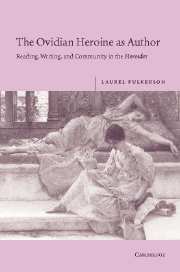Book contents
- Frontmatter
- Contents
- Acknowledgments
- List of abbreviations
- Introduction
- 1 Reading dangerously: Phyllis, Dido, Ariadne, and Medea
- 2 Reading the future?: Hypsipyle, Medea, and Oenone
- 3 Benefits of communal writing: Canace and Hypermestra
- 4 A feminine reading of epic: Briseis and Hermione
- 5 Reading magically: Deianira and Laodamia
- 6 Reading like a virgin: Phaedra and Ariadne
- 7 Caveat lector: thoughts on gender and power
- Appendix: The authenticity (and “authenticity”) of Heroides 15
- Bibliography
- Index
- Index Locorum
Introduction
Published online by Cambridge University Press: 22 September 2009
- Frontmatter
- Contents
- Acknowledgments
- List of abbreviations
- Introduction
- 1 Reading dangerously: Phyllis, Dido, Ariadne, and Medea
- 2 Reading the future?: Hypsipyle, Medea, and Oenone
- 3 Benefits of communal writing: Canace and Hypermestra
- 4 A feminine reading of epic: Briseis and Hermione
- 5 Reading magically: Deianira and Laodamia
- 6 Reading like a virgin: Phaedra and Ariadne
- 7 Caveat lector: thoughts on gender and power
- Appendix: The authenticity (and “authenticity”) of Heroides 15
- Bibliography
- Index
- Index Locorum
Summary
Scholarship on the Heroides generally characterizes them as more-or-less ineffectual letters written by abandoned women to the men who abandon them. Yet this characterization, while not wholly incorrect, is limited; not only do some of the letters fall outside of this description, but to look at the women who write the individual letters as only abandoned deprives them of much of their authorial power. For the Heroides, despite their unpopularity in recent centuries, have been immensely influential on other authors. And, as my Chapter 2 epigraph from the Lettres Portugaises suggests (below, p. 40), a reading of the Heroides that judges solely on the basis of whether the man to whom each letter is addressed returns to the author of that letter reinscribes the tiresome equation of women's personal and professional lives that will be familiar to students of other female artists. More importantly, it misunderstands the aim of poetic composition.
The Heroides are epistles putatively designed to persuade, but although they often fail to persuade their mythological addressees, they have persuaded countless generations of their actual readers to view them as works of literature worthy of imitation. The women of the Heroides are successful in the same way as other elegiac Augustan poets – they may never “get their man” but they create intricate personae and lasting poetry. In fact, the heroines are, because of their very abandonment, perfectly situated to become (like) male Augustan elegists: for both, desire creates poetry.
- Type
- Chapter
- Information
- The Ovidian Heroine as AuthorReading, Writing, and Community in the Heroides, pp. 1 - 22Publisher: Cambridge University PressPrint publication year: 2005

